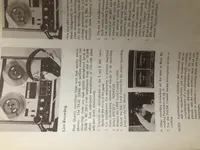Why don't you wait and see if it is in good condition before judgement ?
Oops sorry a very old post, but it still applies...........
I would if I were you check it out first to see the condition of the heads, or ask a friend who knows about reel machines to check it out for you and play a reel tape on it and hear it yourself.
What you should pay for it depends on the condition, I would say it is worth easily $100 and worth more if it is fully Serviced by a Tech and with a Warrantee.
I just love people here on this form jumping to conclusions about reel machines they have never seen or heard in real life.
Before you go assuming that this reel machine is worn out and no good, try it out first in person and listen to it perform.......
I happen to own a Teac 2300s and it is a very good sounding and reliable and fairly compact reel machine, and is built to last a lifetime. With proper maintenance care, lubing and cleaning.
Even if the heads are slightly worn down, with proper maintenance it will sound even better than a CD player or VHS HiFi machine with the right bias reel tape in it. I use Quantey 480 and 406, 407 with good results.
What is nice about Teac is that they give you bias switches on the front face to adjust for tape bias levels for recording and playback of nearly any tape you throw at it. With Teac you can use a wider base of brands of reel tapes with this adjustable machine.
Most Reel to Reel machines are known for their dynamics, great analog full rich sound, and a slight pleasant analog compression at higher recording levels.
A good condition Teac 2300s will sound better and have a higher dynamic range and frequency response of even the best CD players.
Signal to noise ratio is not a problem on most recordings, because analog reel tape sweetens the sound, you will not notice it really. And who cares if there is a little tiny back ground hiss, you can use DBX or Dolby noise reduction, but I don't, because I think it sounds better with out it.
Why don't you hear it first before jumping to conclusions ?!?








